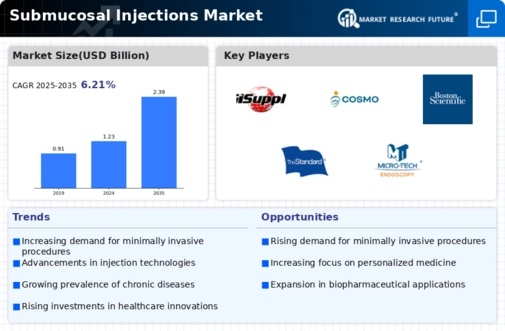Market Analysis
In-depth Analysis of Submucosal Injections Market Industry Landscape
The Pinnacle of Research and Development in Hyaluronic Acid: A Multifaceted Exploration In the dynamic realm of scientific inquiry, hyaluronic acid has become a focal point across various research domains, propelling extensive studies and development initiatives. An article authored by Arianna Fallacara, Erika Baldini, Stefano Manfredini, and Silvia Vertuani in the MDPI journal in June 2018 sheds light on the multifaceted applications of hyaluronic acid and its derivatives, unveiling a spectrum of possibilities in drug delivery systems, cancer therapy, and 3D scaffold structures for cell culture. Diverse Applications in Drug Delivery: The versatility of hyaluronic acid in drug delivery systems is showcased through its utilization alone or in conjunction with other substances to create an array of innovative carriers. Pro-drugs, surface-modified liposomes, nanoparticles, microparticles, and hydrogels represent a selection of these carriers. Notably, hydrogels derived from hyaluronic acid and its chemical derivatives manifest as 3D polymeric networks, proving invaluable in the topical delivery of cells and various active ingredients. This includes anti-inflammatories, antibacterial agents, antibodies, and proteins, thereby broadening the spectrum of therapeutic applications. In the realm of cancer therapy, studies have elucidated the overexpression of the CD44 receptor in diverse tumor cells, correlating with an increased affinity for hyaluronic acid binding and internalization. This revelation has positioned the CD44 receptor as a potential target for cancer therapy, with hyaluronan emerging as a potent ligand for the development of targeted therapies. Hyaluronic acid's dual role as a drug carrier and targeting agent is exemplified through polymer-antitumoral conjugates and delivery systems encapsulating anti-cancer drugs. This dual functionality holds promise for more effective and targeted cancer treatments. According to a report published in the Journal of Pharmaceutical Investigation in May 2019, the chemical modification of hyaluronic acid and the fabrication of hyaluronic acid-based nano systems open avenues for diverse clinical applications. These advancements underscore the significance of ongoing research and development efforts in harnessing hyaluronic acid's potential for groundbreaking medical interventions. 3D Scaffold Structures for Cell Culture: Beyond its role in drug delivery, hyaluronic acid and its synthetic derivatives emerge as pivotal components in the creation of 3D scaffold structures, providing physical support for in-vitro cell culture. Specific derivatives, characterized by aldehyde and hydrazide groups, have been instrumental in developing biomimetic 3D culture systems. For instance, these systems have been employed in creating a supportive environment for poorly adherent metastatic prostate cancer cells, serving as an in-vitro platform to assess the efficacy of anticancer drugs. This innovative approach not only provides a more accurate representation of the in-vivo environment but also offers a testing ground for potential therapeutic interventions. Conclusion: In conclusion, the extensive research and development associated with hyaluronic acid underscore its significance as a versatile and promising component in the field of medical science. From revolutionary drug delivery systems with targeted applications to the creation of 3D scaffold structures for advanced cell culture, hyaluronic acid continues to unveil its potential across diverse domains. The interplay between scientific exploration and technological innovation is shaping a future where hyaluronic acid stands at the forefront of transformative medical applications, promising improved therapeutic outcomes and novel solutions to complex healthcare challenges. As research endeavors persist, the full spectrum of hyaluronic acid's capabilities is yet to be fully realized, offering a glimpse into the boundless possibilities that lie ahead in the realm of medical advancements.









Leave a Comment